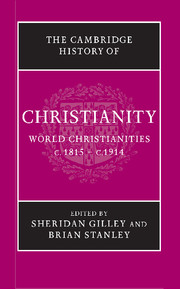Book contents
- Frontmatter
- 1 Introduction
- PART I CHRISTIANITY AND MODERNITY
- PART II THE CHURCHES AND NATIONAL IDENTITIES
- 14 Catholic Christianity in France from the Restoration to the separation of church and state, 1815–1905
- 15 Italy: the church and the Risorgimento
- 16 Catholicism, Ireland and the Irish diaspora
- 17 Catholic nationalism in Greater Hungary and Poland
- 18 Christianity and the creation of Germany
- 19 Anglicanism, Presbyterianism and the religious identities of the United Kingdom
- 20 Protestant dominance and confessional politics: Switzerland and the Netherlands
- 21 Scandinavia: Lutheranism and national identity
- 22 ‘Christian America’ and ‘Christian Canada’
- 23 Spain and Portugal: the challenge to the church
- 24 Latin America: the church and national independence
- 25 Between east and west: the Eastern Catholic (‘Uniate’) churches
- PART III THE EXPANSION OF CHRISTIANITY
- Select General Bibliography
- Chapter Bibliography
- Index
- References
25 - Between east and west: the Eastern Catholic (‘Uniate’) churches
from PART II - THE CHURCHES AND NATIONAL IDENTITIES
Published online by Cambridge University Press: 28 March 2008
- Frontmatter
- 1 Introduction
- PART I CHRISTIANITY AND MODERNITY
- PART II THE CHURCHES AND NATIONAL IDENTITIES
- 14 Catholic Christianity in France from the Restoration to the separation of church and state, 1815–1905
- 15 Italy: the church and the Risorgimento
- 16 Catholicism, Ireland and the Irish diaspora
- 17 Catholic nationalism in Greater Hungary and Poland
- 18 Christianity and the creation of Germany
- 19 Anglicanism, Presbyterianism and the religious identities of the United Kingdom
- 20 Protestant dominance and confessional politics: Switzerland and the Netherlands
- 21 Scandinavia: Lutheranism and national identity
- 22 ‘Christian America’ and ‘Christian Canada’
- 23 Spain and Portugal: the challenge to the church
- 24 Latin America: the church and national independence
- 25 Between east and west: the Eastern Catholic (‘Uniate’) churches
- PART III THE EXPANSION OF CHRISTIANITY
- Select General Bibliography
- Chapter Bibliography
- Index
- References
Summary
‘Uniate’ churches comprise Eastern Christians who either reaffirmed their never formally broken communion with Rome, or left their Orthodox mother churches to join the Catholic communion. They derive from all seven extant Eastern Christian traditions – Armenian, Byzantine, Coptic and Ethiopian and those of Syriac provenance: East-Syrian or Mesopotamian, represented today by the Chaldean and Syro-Malabar Catholic churches, West-Syrian or Syro-Antiochene by the Syrian Catholic Church (another branch of the same tradition, the Syro-Malankara Catholic Church, dates only from the 1930s); and the Maronite Church of Lebanon, which shares elements of both East- and West-Syrian provenance. The last is the only Eastern church that is entirely Catholic, and only the Chaldean and Syro-Malabar churches are larger than their Orthodox counterparts. These churches are all mono-ethnic except those of the Byzantine tradition, which includes communities of Albanian, Georgian, Greek, Hungarian, Melkite or Arab, Romanian, and Slavic ‘Greek Catholics’, the name Empress Maria Theresa invented in 1774 to distinguish them from their ‘Latin Catholic’ coreligionists.
The history of these minorities, subject to Latin meddling and paternalism within the Roman communion and shunned by their Orthodox mother churches, was largely conditioned by their turbulent relation to these much larger church bodies in whose shadow they were fated to live.
At the sunset of the empires
The turbulent century from the Congress of Vienna until the Great War witnessed the destruction of the three territorially integral multi-ethnic empires of the day: the Austro-Hungarian empire in which Eastern Catholics flourished; the Tsarist Russian empire in which they were persecuted and violently suppressed; and the Ottoman empire in which they were initially tolerated, eventually protected and allowed to flourish, and finally massacred.
- Type
- Chapter
- Information
- The Cambridge History of Christianity , pp. 412 - 426Publisher: Cambridge University PressPrint publication year: 2005

